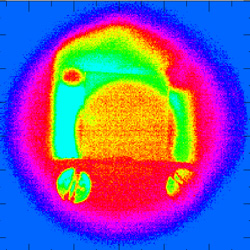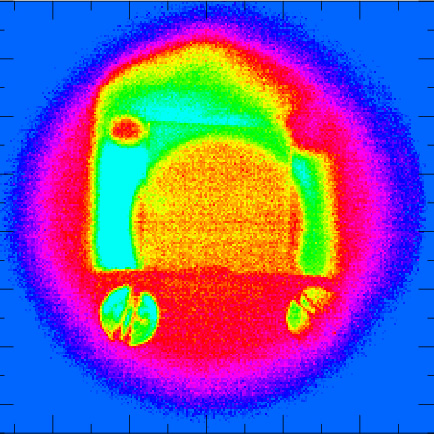The Little Chill
Some lasers can burn through solids, but others, shined on the right materials, have a chilling effect. In the 21 July PRL, researchers report that two materials containing the element erbium cool when exposed to laser light. Other researchers have seen the effect with other elements, but erbium would allow cooling at wavelengths and powers reachable by common laser diodes, suggesting that small refrigeration devices for electronics and other high-tech purposes might be possible.
In 1950, Alfred Kastler of the École Normale Superieure in Paris first suggested that solids doped with rare-earth ions could cool via a process known as anti-Stokes emission. Anti-Stokes emission occurs when a material emits more energy than it absorbs, explains Angel Garcia-Adeva of the University of the Basque Country (EHU) in Spain. The key is to shine photons onto the material that fall short of the energy needed to excite its atoms to a higher energy level. The material makes up the difference using the energy from thermal vibrations, which are ever-present from random atomic motion. The atoms absorb these thermal vibrations, or phonons, become excited, and then fluoresce, carrying energy away and cooling the material.
Hoping to develop new cooling devices, researchers have laser-cooled materials containing ytterbium and thulium–by 85 degrees Celsius in one case. Erbium, though, has always been of interest to researchers, says Zameer Hasan of Temple University in Philadelphia, whose group has been working with erbium-doped materials. To become excited, erbium requires light of 1.5 microns in wavelength, which is common in fiber-optic communications. And it can be excited with little laser power. But erbium has a more complicated energy level scheme than the other two elements, which has made some researchers skeptical that a material could be engineered with the right set of atomic vibrations to make it work, Hasan says.
Garcia-Adeva and his EHU colleagues Rolindes Balda and Joaquin Fernandez have now laser cooled two erbium-doped materials, a crystal (potassium lead pentachloride) and a glass (a heavy-metal fluorochloride). The team was able to rid their materials of impurities that would scatter light and heat the samples, thus preserving the materials’ precisely tuned phonon energies. They focused a laser onto the samples and mapped the temperature with an infrared camera. The drops in the average temperature were small, says Garcia-Adeva–0.7 degrees Celsius for the crystal and 0.5 degrees Celsius for the glass. “But there are ways to optimize using different configurations, so you can reach larger temperature differences,” he says. “This was more like a proof of concept that these materials could be cooled.”
This and other laser-cooled materials “could be a path to low-temperature, high-efficiency optical refrigerators,” says Richard Epstein of Los Alamos National Laboratory in New Mexico. He thinks the most likely uses would be for detectors such as infrared cameras that must be cooled below the temperatures available with common thermoelectric cooling devices. Hasan imagines that a thin layer of a laser-cooled material incorporated into a computer chip could help dissipate heat and allow it to run faster and more reliably. The research might also lead to new materials for fiber optics, says Garcia-Adeva. “That’s one of the possibilities we are considering, that you can cool the fiber at the same time you are using it to amplify the signal.”
–Corinna Wu
Corinna Wu is a freelance science writer in Alexandria, Virginia.





